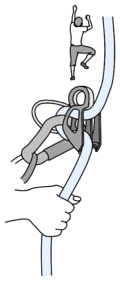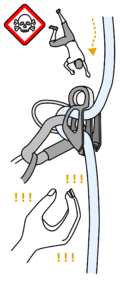Tuber (Tubular belay device): Difference between revisions
→Belaying risks: - shortened for Tuber specific |
|||
| Line 18: | Line 18: | ||
|120px | |120px | ||
|Always hold the break strand downwards unless feeding the rope | |Always hold the break strand downwards unless feeding the rope | ||
|File:tuber_nohand.png | |||
|120px | |||
|Not holding the break strand can result in fatal injuries | |||
|File:tuber_warn_closehand.png | |File:tuber_warn_closehand.png | ||
|130px | |130px | ||
| Line 23: | Line 26: | ||
}} | }} | ||
TODO: Gallery - | TODO: Gallery - hand-too-high | ||
</translate> | </translate> | ||
Revision as of 05:53, 24 August 2025
Tubular belay devices are the most commonly used belay devices during training of advanced climbing and rescue techniques, multipitching and management of twin/double ropes. In some countries/clubs, they have been replaced by assisted tubular belay devices for single-pitch training. They are prohibited in some gyms due to alleged security concerns (for details, see the security concerns section).
Belaying risks
Always hold/control the break strand at least with one hand and keep the break strand downwards. Keep your hand at least a few centimeters from the belay device to avoid pinching of the skin. Do not lift your hand too high (above the device) while giving the slack. One of the commonly seen bad habit is keeping the hand raised for a prolonged amount of time during belaying.
TODO: Gallery - hand-too-high



